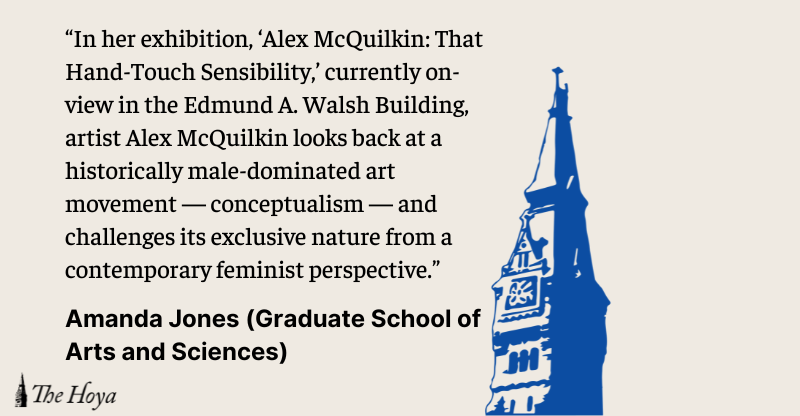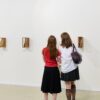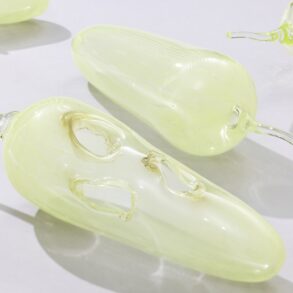
In the Lucille M. & Richard F. X. Spagnuolo Art Gallery, nine three-foot aluminum embroidery hoops are affixed to pink, papered walls. In her exhibition, “Alex McQuilkin: That Hand-Touch Sensibility,” currently on-view in the Edmund A. Walsh Building, artist Alex McQuilkin looks back at a historically male-dominated art movement — conceptualism — and challenges its exclusive nature from a contemporary feminist perspective.
Hand stitched onto the pastel hoops are quotes that McQuilkin has selected from 20th century U.S. artist Sol LeWitt’s 1967 “Paragraphs on Conceptual Art.” As explained on the wall of the exhibit, the quotes express “heroic and gendered language,” which McQuilkin has ironically sewn onto oversized dyed pieces of diaper fabric to challenge LeWitt’s theories of what constitutes legitimate art. LeWitt disapproved of the handmade and craft-like works of art that historically have been associated with the feminine sphere and McQuilkin rejects that notion with her embroidery hoops. In her exhibition statement displayed on the wall of the Spagnuolo Gallery, curator Helaine Posner (CAS ’75) says that in “That Hand-Touch Sensibility,” “McQuilkin creates a stereotypically soft, pastel domestic interior to examine the messages society sends about feminized labor, and does so with humor and wit.”
In her comments on the exhibition, McQuilkin says she was inspired to critique the popular minimalist style of the 1960s and 1970s that intentionally ostracized female artists and rejected the cultural conventions it implies. Art in the 20th and 21st centuries asked their audience tough questions about our world. Intentionally meant to be reflective, contemporary art allows the viewer to contemplate larger social, political and cultural themes and how we can change and grow together. Yet historically, these questions have been driven by white male artists. The eras of art that McQuilkin critiques — conceptualism and minimalism — are no exceptions and there is a lack of female representation among the popular artists of the time. To correct this oversight, it is our job in the 21st century to feature women’s art and allow them to be at the forefront of conversations.
Highlighting female artists in our on-campus gallery space is the first step to rebut stereotypical gender roles that are still upheld by the art community. Since the opening of the Georgetown University Art Galleries, there have been eight shows solely dedicated to female artists and a large presence in group exhibitions. By giving them a physical space to be represented in, we are in turn making room for women artists in the canon of art history.
With McQuilkin’s exhibition, the Galleries takes crucial steps to showcase the struggles of female artists, especially those with children. As a mother herself, McQuilkin reflects on how her own life has changed since the birth of her two children. Originally working in filmmaking and painting, she adapted her practice to fit her new lifestyle, working in embroidery at the kitchen table. By spotlighting her work in a solo exhibition, McQuilkin’s lived experiences as both a working artist and mother are placed at the forefront of a conversation that has historically omitted women like her.
There is so much more we can do as a Georgetown community to uplift past and present female artists, ensuring that their work and lived experiences are preserved. Continuing the trend of exhibitions dedicated to women’s art in our on-campus gallery spaces is essential and something the Galleries are committed to, with its mission stating that it is “a forum for art that sparks conversation and encourages social engagement through a contemporary lens.” However, the next step we can take as a larger campus is visiting these spaces. No matter what discipline you study, there is something to learn through engagement with art, and the second half of the Galleries’ mission, to “promote cross-disciplinary learning, inspire dialogue, and challenge assumptions through changing exhibitions and programs for a variety of audiences,” demonstrates this.
Beyond the gallery space, the construction of classes around the work and the lives of female artists is another way we can highlight their perspectives and rebut stereotypical gender roles that are still being upheld by the art community and historical canon. Around the larger Washington, D.C., area, we can attend programming about female artists at places like the National Museum of Women in the Arts and attend galleries that represent living female artists. These are just a sample of things we can participate in to further promote the support of female art and artists. I encourage Georgetown to think about how we on campus can make space to include the voices of female artists in our academic community and beyond to help share experiences that are excluded from the art historical narrative. McQuilkin’s “That Hand Touch Sensibility” is on view now through Dec. 8.
Amanda Jones is a student in the Graduate School of Arts and Sciences.
This post was originally published on this site be sure to check out more of their content







